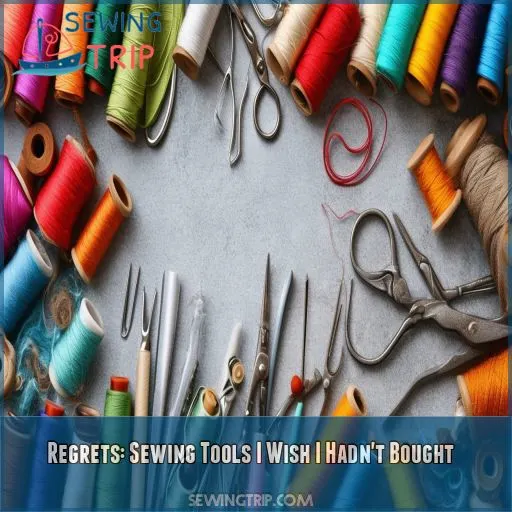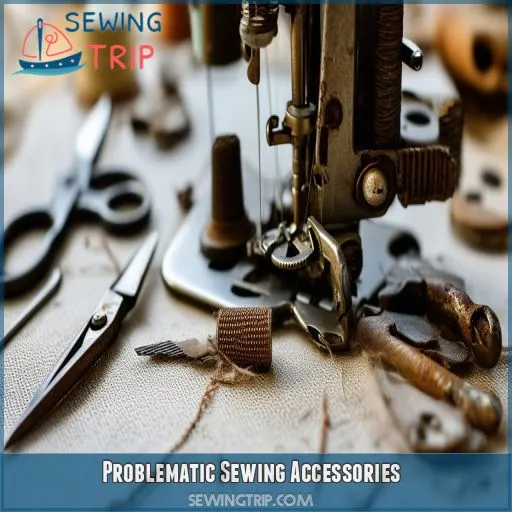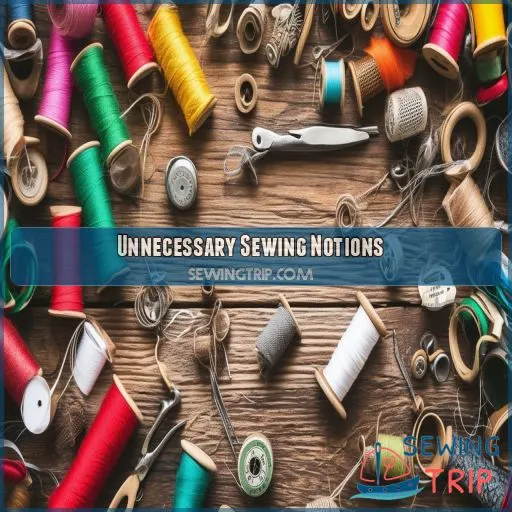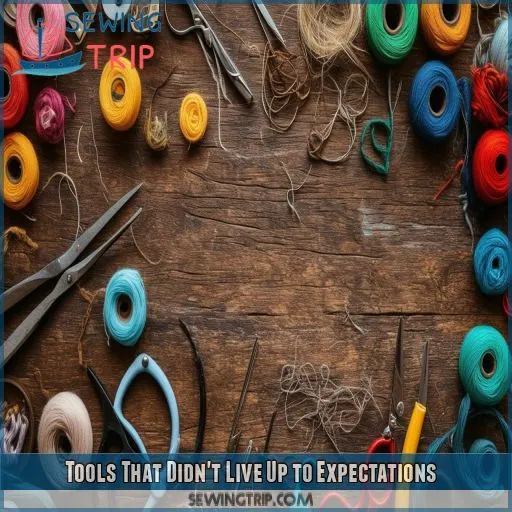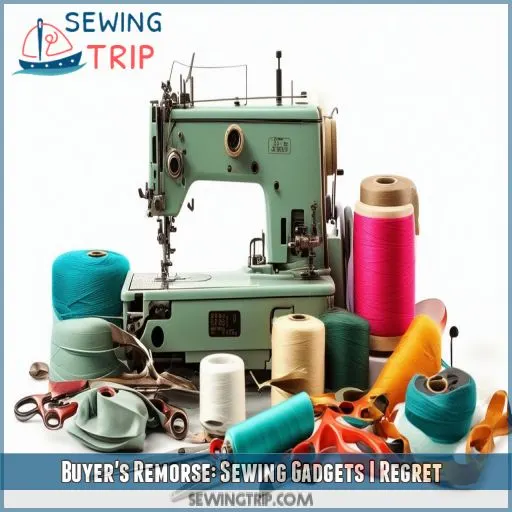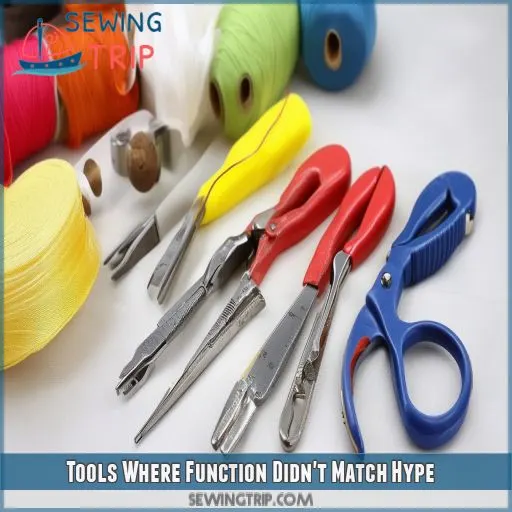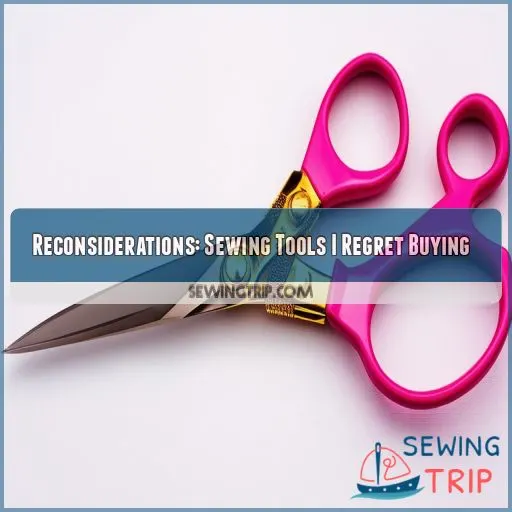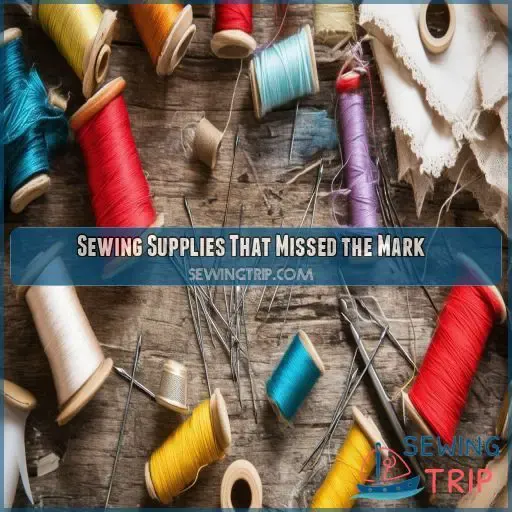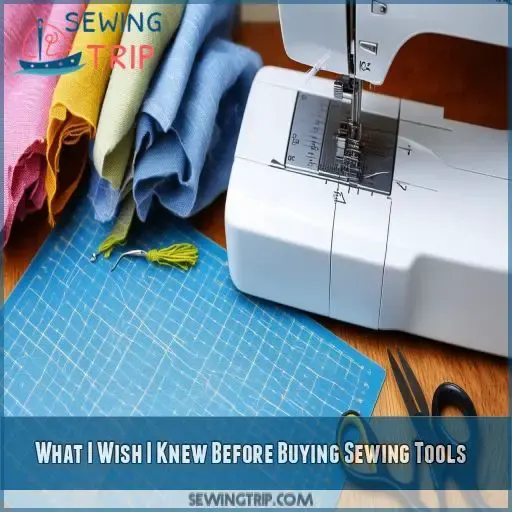This site is supported by our readers. We may earn a commission, at no cost to you, if you purchase through links.
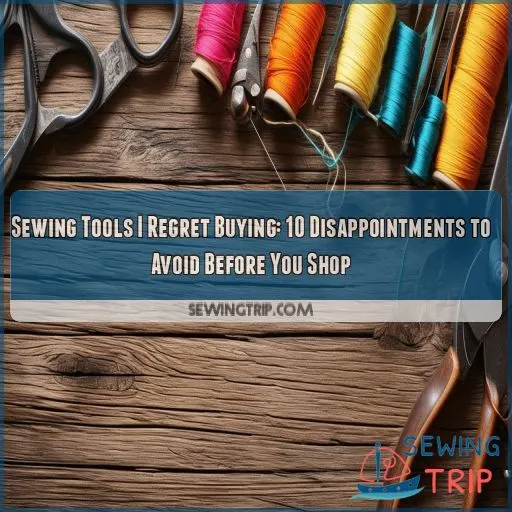
Fast-forward a little, and what used to be your craft room is now a graveyard of unused gadgets.
Avoid buyer’s remorse with this guide, in which we’ll discuss 10 sewing tools I wish I’d never bought. Now, you’ll discover the disappointing purchases you should avoid and thus save time, money, and very precious storage space in the process.
Equip yourself with the knowledge and avoid these blunders on the way to sewing greatness.
Table Of Contents
- Key Takeaways
- The Most Disappointing Sewing Machine Purchase
- Regrets: Sewing Tools I Wish I Hadn’t Bought
- Problematic Sewing Accessories
- Unnecessary Sewing Notions
- Tools That Didn’t Live Up to Expectations
- Buyer’s Remorse: Sewing Gadgets I Regret
- Tools Where Function Didn’t Match Hype
- Reconsiderations: Sewing Tools I Regret Buying
- Sewing Supplies That Missed the Mark
- What I Wish I Knew Before Buying Sewing Tools
- Frequently Asked Questions (FAQs)
- Conclusion
Key Takeaways
- Don’t let those shiny new gadgets lure you in like a moth to a flame – sometimes the fanciest sewing machine is just an expensive dust collector. Stick to your true needs and skill level when shopping.
- Beware the siren song of "revolutionary" tools that promise to change your sewing game. Many end up being one-trick ponies that clutter up your craft room faster than you can say "impulse buy."
- Quality over quantity is the name of the game. It’s better to have a lean, mean sewing machine (pun intended) than a hodgepodge of flimsy gadgets that fall apart faster than a badly sewn seam.
- Do your homework before splurging on new tools. A little research goes a long way in avoiding buyer’s remorse and keeping your sewing sanctuary from turning into a graveyard of regrettable purchases.
The Most Disappointing Sewing Machine Purchase
You’ve saved up, researched for months, and finally pulled the trigger on that shiny new sewing machine. But after a few projects, you’re left wondering, "Did I make a mistake?"
The most disappointing sewing machine purchase often comes down to mismatched expectations. Maybe you splurged on a computerized wonder with hundreds of stitches you’ll never use, when a reliable mechanical model would’ve sufficed. Or perhaps you fell for the allure of a vintage treadle machine, only to find it’s more hassle than heirloom.
Buyer’s remorse can hit hard when you realize that pricey investment is gathering dust.
Before you shop, consider your true needs and skill level. Don’t let flashy features or nostalgia cloud your judgment. Remember, the best sewing machine is the one you’ll actually use – not the one with the biggest price tag.
Regrets: Sewing Tools I Wish I Hadn’t Bought
While sewing machines can sometimes be a real pain, those other small tools in your tool kit seem to make you scratch your head. Let’s dive into the regrets that lurk in your sewing kit.
You have likely fallen prey to shiny new devices at some point or another in your life, but most know not everything that shines is gold in sewing. Keeping your toolkit lean and mean means avoiding those impulse purchases. Before you click "buy," do yourself a favor and research—read—the reviews. Are fancy thread cutters worth the splurge, or will your trusty sewing scissors do the job just fine?
Prioritize your needs over wants, and this will keep the space and wallet full. Consider what costs more: the cost versus the value of the item. That new see-and-breathe type of rotary cutter may look very enticing, but when not quilting regularly, it might collect dust. Most importantly, keep in mind that the best tools are those that one can use.
Problematic Sewing Accessories
You’ve likely encountered problematic sewing accessories that promised to revolutionize your craft but fell short.
Take the overpriced Elna Press, for instance. While it boasts a large pressing surface, its bulky design and inconsistent performance make it a regrettable purchase for many.
The thread stand, often touted as a must-have, can be more trouble than it’s worth, with its flimsy build quality leading to frequent toppling and tangled threads.
Don’t be fooled by the allure of a fancy sewing table; some lack versatility and prove impractical for various projects.
Even seemingly simple tools like sleeve rolls can disappoint, with poor construction resulting in uneven pressing.
And let’s not forget about irons – those high-end models with countless settings often overcomplicate what should be a straightforward task.
Unnecessary Sewing Notions
You’ve likely encountered those enticing sewing notions that promise to revolutionize your craft. But beware – not all gadgets live up to the hype.
Needle threaders, for instance, often prove more frustrating than helpful. Home steamers, while seemingly convenient, rarely outperform a good iron and press cloth. Speaking of press cloths, specialized ones can be unnecessary when a scrap of silk organza does the job just fine. Fancy pressing mats might catch your eye, but a well-padded ironing board often suffices.
Don’t be fooled by marketing claims of "must-have" sewing supplies. Many of these unnecessary tools end up collecting dust in your sewing room.
Before you buy, ask yourself: Will this truly enhance my sewing process? Can I achieve the same result with tools I already own? By critically evaluating potential purchases, you’ll avoid cluttering your space with regrettable sewing notions.
Tools That Didn’t Live Up to Expectations
Stepping right along from redundant concepts, let’s get into tools that promised the moon and delivered a pincushion. You’ve probably had some sewing gadgets that were less than stellar. Three of the most common culprits are:
- The "miracle" steam iron that barely spits out any steam
- The point turner duller than your grandma’s scissors
- The organza press cloth that melts faster than your patience
These disappointments often come forth from misleading product descriptions or reviews that mislead. You might’ve fallen for the hype of a double tracing wheel, only to find out it’s functionality more limited than a one-armed tailor. Or perhaps you wrestled with tools that are counterfeit but marketed as name-brand quality. Poor customer service compounds these frustrations, and now it’s like you’re sewn up. Keep in mind that just because something sparkles or shines in the sewing aisle, it doesn’t have to be golden; sometimes really simple tools can do the trick best.
Buyer’s Remorse: Sewing Gadgets I Regret
You’ve learned about tools that didn’t quite come up to expectation, but let’s get into some specific gadgets that might’ve you feeling buyer’s remorse. We’ve all been there: suckered in by the promise of some revolutionary sewing tool, only to realize it’s now collecting dust in a drawer. Here is a list of common regrets:
| Gadget | Why It Disappoints | Better Alternative |
|---|---|---|
| Inexpensive Buttonhole Attachment | Inconsistent quality results | Quality machine built-in |
| Fancy Ruler Set | Overcomplicated, rarely used | Basic clear ruler |
| IKEA Hack Cutting Table | Unstable, poor storage | Pro cutting mat |
Tools Where Function Didn’t Match Hype
You’ve probably encountered those flashy sewing tools that promise to revolutionize your craft, only to find they’re more hype than help. Let’s talk about the disappointments that didn’t live up to their marketing buzz.
Remember that fancy rotary cutter with all the bells and whistles? Turns out, it’s no more effective than your trusty old model. Or how about that pricey serger attachment that claimed to do it all? In reality, it’s just gathering dust in your sewing room.
Tool functionality often falls short of expectations, leaving you wondering if the hype was worth your hard-earned cash. Consider the ergonomic concerns of that "revolutionary" seam ripper that’s actually more uncomfortable than your basic version.
When evaluating new tools, always weigh the feature overlap with what you already own. Sometimes, the value for money just isn’t there, no matter how enticing the promises.
Reconsiderations: Sewing Tools I Regret Buying
You’ve likely encountered sewing tools that didn’t live up to their promises, leaving you with buyer’s remorse. Let’s examine some common pitfalls, including overpriced gadgets that gather dust, impractical specialty tools, and items where quality doesn’t match the price tag, so you can make smarter choices for your sewing toolkit.
Sewing Tools I Regret Buying
We’ve all fallen for the multitude of sewing tools and their subsequent regret purchases. Here are five common culprits:
- Plastic bodkins, flimsy and easily bent
Cheap fabric markers that bleed or don’t wash out.
- Rotary cutters that are poorly constructed and with blunt blades
- Novelty pins that catch on delicate fabrics
- Unreliable automatic needle threaders
These impulse purchases usually result from false advertisements or poor quality control. Do thorough research and go through reviews before buying to get past these duplicate tools and frustrations in your sewing room.
Overpriced Gadgets Rarely Used
You’ve likely encountered those flashy sewing gadgets that promise to revolutionize your craft. But beware of overpriced tools that end up collecting dust.
From fancy pinking shears made with uncommon materials to electric scissors with poor craftsmanship, these purchases often lead to disappointment. Their impractical design and lackluster results rarely justify the hefty price tag.
Impractical Specialty Tools
You’ve likely encountered specialty sewing tools that seemed revolutionary but ended up gathering dust. These impractical gadgets often come with a hefty price tag and niche applications. Before splurging on the latest gizmo, consider:
- How often you’ll actually use it
- If it solves a genuine problem in your sewing process
- Whether a simpler, more versatile tool could do the job
Don’t let fancy marketing fool you into unnecessary purchases that’ll clutter your workspace.
Quality Vs. Quantity Issues
While specialty tools can be hit-or-miss, it’s equally important to consider quality versus quantity when stocking your sewing arsenal.
You may want to opt for the cheapest versions, but remember: you often get what you pay for. Material quality and durability concerns should be at the forefront of your decision-making.
There are brand reputation and warranty considerations as well.
It’s better to have fewer high-quality tools rather than a drawer full of subpar gadgets that aren’t going to last you very long.
Sewing Supplies That Missed the Mark
As you dive deeper into your sewing journey, you’ll encounter tools that simply don’t live up to the hype. Remember those specialty presser feet you bought on a whim? They’re probably gathering dust in your drawer. It’s not just about the money wasted; it’s the disappointment of unfulfilled potential**.
That pricey serger you splurged on? It’s been more trouble than it’s worth, with constant tension issues. And let’s not forget the stack of bargain-bin fabrics that seemed like a steal but turned out to be nightmares to work with.
These experiences teach you to be more discerning, to research before you buy, and to trust your instincts. Quality over quantity becomes your mantra. You’ll learn to spot the difference between genuinely useful tools and flashy gimmicks, saving both your wallet and your sanity in the long run.
What I Wish I Knew Before Buying Sewing Tools
There is much to consider before jumping headfirst into the sea of sewing tools. First of all, research it. Don’t fall prey to fancy marketing or peer pressure. What’s lacking in your current setup? Focus on that.
The price-to-value ratio is important; what looks expensive doesn’t necessarily mean it’s better. Find budget-friendly options that would do just as fine a job. Some tools are overrated; others are underrated gems.
Take time to go through reviews from people who have experience sewing, and watching tutorial videos will let you see tools in action.
It’s not about having all gadgets available on the market; it’s about building a kit that will work for your specific needs. Start with basics, and add more as you grow.
Frequently Asked Questions (FAQs)
How can I resell or repurpose unwanted sewing tools?
You’ve got options! Sell unwanted tools online or at sewing meetups. Repurpose them for crafts or donate to schools. Remember, one sewist’s castoff is another’s treasure. Get creative and give those tools a new life!
Are there alternatives to expensive, specialized sewing gadgets?
Don’t let fancy gadgets sew up your budget! You’re the master of your craft. Use everyday items like bobby pins for threading, binder clips for holding fabric, and a fork for marking pleats. Creativity trumps costly tools.
Which sewing tools have the best resale value?
You’ll find high-end sewing machines, sergers, and vintage machines hold their value best. Quality scissors, like Gingher, and durable pressing tools also resell well. Invest in reputable brands and maintain your tools to maximize resale potential.
How do I avoid impulse purchases of sewing accessories?
Don’t let the sewing accessory store become a candy shop for your wallet. Create a wishlist, research thoroughly, and wait before buying. Set a budget, prioritize essentials, and consider borrowing or renting tools for infrequent use.
What factors contribute to buyers remorse in sewing tools?
Buyer’s remorse will set in if you act on hype, don’t put enough research into it, or buy tools beyond your skill levels. Other factors that can lead to a rueful acquisition of tools are making impulsive purchases, overestimating needs, and failing to consider long-term value.
Conclusion
It’s a jungle of sewing tools out there, but now you’re armed with the knowledge that will help you avoid some really quite expensive mistakes. If you steer clear of these 10 disappointing purchases, you’ll save yourself from wasting money and space, enabling you to concentrate on tools that actually turn out to be really useful in your craft.
It’s not about having every gadget but choosing wisely. As you continue in your sewing journey, remember this guide to avoid buyer’s remorse.
The sewing tools you regret buying today can become valuable lessons for smarter shopping tomorrow.


